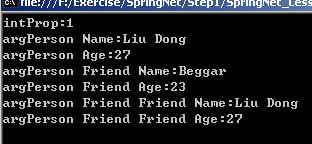Spring.NET教程(六)——依赖对象的注入(基础篇)
上篇我们简单提到依赖注入的用途。回顾一下所讲内容,发现在object节点下使用了<property name="Tool" ref="computer"/>。而property 标签正是用来属性注入的。而ref是用来标识是关联到哪个object。而name属性是指属性名。如下:
<object id="modernPerson" type="SpringNetIoC.ModernPerson, SpringNetIoC">
<property name="Tool" ref="computer"/>
</object>
值类型的注入是需要使用property 节点的value属性。如<property name="Name" value="Liu Dong"/>
作为内联类型可以使用如下:
<property name="Friend">
<object type="SpringNetDi.Person, SpringNetDi"/>
</property>
同理,内联类型可以是循环引用的对象(见代码处)。
二、构造函数注入
构造器注入使用constructor-arg标签作为标识。同样具有于属性注入相同的方式,使用name、ref、value作为构造器注入的属性,如下:
<constructor-arg name="argPerson" ref="person"/>
<constructor-arg name="intProp" value="1"/>
程序的代码如下:
public class Person
{
public string Name { get; set; }
public int Age { get; set; }
public Person Friend { get; set; }
}
PersonDao
public class PersonDao
{
private Person argPerson;
private int intProp;
public PersonDao(Person argPerson, int intProp)
{
this.argPerson = argPerson;
this.intProp = intProp;
}
public void Get()
{
//构造函数注入的整型参数
Console.WriteLine(string.Format("intProp:{0}", intProp));
//构造函数注入的Person
Console.WriteLine(string.Format("argPerson Name:{0}", argPerson.Name));
Console.WriteLine(string.Format("argPerson Age:{0}", argPerson.Age));
//内联对象Friend
Console.WriteLine(string.Format("argPerson Friend Name:{0}", argPerson.Friend.Name));
Console.WriteLine(string.Format("argPerson Friend Age:{0}", argPerson.Friend.Age));
//内联对象的循环引用
Console.WriteLine(string.Format("argPerson Friend Friend Name:{0}", argPerson.Friend.Friend.Name));
Console.WriteLine(string.Format("argPerson Friend Friend Age:{0}", argPerson.Friend.Friend.Age));
}
}
App.config
<?xml version="1.0" encoding="utf-8" ?>
<configuration>
<configSections>
<sectionGroup name="spring">
<section name="context" type="Spring.Context.Support.ContextHandler, Spring.Core" />
<section name="objects" type="Spring.Context.Support.DefaultSectionHandler, Spring.Core" />
</sectionGroup>
</configSections>
<spring>
<context>
<resource uri="config://spring/objects" />
</context>
<objects xmlns="http://www.springframework.net">
<object id="person" type="SpringNetDi.Person, SpringNetDi">
<!--属性值类型注入-->
<property name="Name" value="Liu Dong"/>
<property name="Age" value="27"/>
<!--内联对象注入-->
<property name="Friend">
<object type="SpringNetDi.Person, SpringNetDi">
<property name="Name" value="Beggar"/>
<property name="Age" value="23"/>
<property name="Friend" ref="person"/>
</object>
</property>
</object>
<object id="personDao" type="SpringNetDi.PersonDao, SpringNetDi">
<!--构造器注入-->
<constructor-arg name="argPerson" ref="person"/>
<constructor-arg name="intProp" value="1"/>
</object>
</objects>
</spring>
</configuration>
Program
class Program
{
static void Main(string[] args)
{
IApplicationContext ctx = ContextRegistry.GetContext();
PersonDao dao = ctx.GetObject("personDao") as PersonDao;
dao.Get();
Console.ReadLine();
}
}
输出效果如下:
